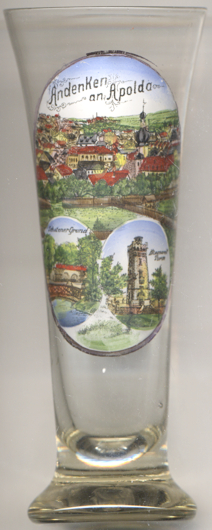

|
| DEUTSCHLAND | GERMANY |
| Bundesland: Freistaat Thüringen | Thuringia |
| Landkreis: Weimarer Land |
Apolda is situated at an elevation of 205 m on the river Ilm in Germany's state of Thuringia, about 14 km northnortheast of Weimar and about 34 km east of Thuringia's capital, Erfurt. Apolda is the seat of the administration of the district Weimarer Land. The municipality has a population of about 22,900 (2023).
Apollde was first mentioned in a document of 1119, a castle was first mentioned in 1123. By 1289 Apolda had obtained the status of a town. Since the end of the 16th century the place was well-known for its production of stockings. In 1663 the university of Jena was given the jurisdiction over Apolda and held this right for more than 200 years. Apolda is also well-known for the production of bells, a tradition that goes back to 1722. The large bell (St. Peter's bell) of the cathedral of Cologne was cast here in 1923. Until 1998 it was the world's largest free-swinging bell (about 24,000 kg).

The  Rathaus (town hall) [left, no. 4191, and below, no. 1439: bottom right picture]
dates back to 1558/1559 in place of the first town hall, which hadbeen built around 1336. In 1669 a tower with a clock and bells were added.
After a fire the new town hall was rebuilt in 1673/1674. After more than 300 years, the town hall in in the basement finally closed in 1890.
An extension of the town hall was added in 1867/1868.
Rathaus (town hall) [left, no. 4191, and below, no. 1439: bottom right picture]
dates back to 1558/1559 in place of the first town hall, which hadbeen built around 1336. In 1669 a tower with a clock and bells were added.
After a fire the new town hall was rebuilt in 1673/1674. After more than 300 years, the town hall in in the basement finally closed in 1890.
An extension of the town hall was added in 1867/1868.

The  Carolinenheim [near left, no. 1439: top picture]
was built in 1908 in Art Nouveau style as Thuringia's first 'Institution for the Sick and Epileptics' ("Anstalt für Sieche und Epileptische").
The entire building complex, built between 1906 and 1912, is today the historic headquarters of the Carolinenheim Foundation.
Carolinenheim [near left, no. 1439: top picture]
was built in 1908 in Art Nouveau style as Thuringia's first 'Institution for the Sick and Epileptics' ("Anstalt für Sieche und Epileptische").
The entire building complex, built between 1906 and 1912, is today the historic headquarters of the Carolinenheim Foundation.
The  Lutherkirche (Protestant town church) [bottom left picture]
is the largest of the four churches in Apolda. It was built in Neo-Gothic Historicist style in 1890–1894 by the architect Johannes Otzen.
Unusual for the region, it was constructed in brick Gothic style.
Lutherkirche (Protestant town church) [bottom left picture]
is the largest of the four churches in Apolda. It was built in Neo-Gothic Historicist style in 1890–1894 by the architect Johannes Otzen.
Unusual for the region, it was constructed in brick Gothic style.

The  church of St. Martin [near left, no. 4666: top picture: right]
was firstmentioned in 1119. Of this early Romanesque church parts of the wall and the foundation of an altar have remained.
Although the church must have been remodeled already in the Gothic period, the oldest documents on alterations date from 1671 onwards.
With the construction of the Luther Church in 1894, St. Martin’s Church lost its importance as a town church.
In 1925/1926 the nave was separated from the choir and only the nave remained in use for church services. Renovations took place
in 1973/1974, 1980 and 2003.
church of St. Martin [near left, no. 4666: top picture: right]
was firstmentioned in 1119. Of this early Romanesque church parts of the wall and the foundation of an altar have remained.
Although the church must have been remodeled already in the Gothic period, the oldest documents on alterations date from 1671 onwards.
With the construction of the Luther Church in 1894, St. Martin’s Church lost its importance as a town church.
In 1925/1926 the nave was separated from the choir and only the nave remained in use for church services. Renovations took place
in 1973/1974, 1980 and 2003.
The view depicted in the lower left picture on glass no. 4666 is labeled
 Schotener Grund
Schotener Grund
The  Bismarck tower [bottom right picture] of Apolda is one of the 17 still existing
examples of this type of monument in Thuringia. The tower was erected in 1902–1904. It has a total height of 23.75 metres
and has an observation deck at 19.65 metres. Transmission and reception systems for antenna television were installed in the early
1970s so that it was no longer accessible for visitors. It was made accessible again in 1974, but had to be closed again in 1994 due
to structural reasons. Since 2004 it has been open again as an observation tower on weekends during the summer months.
(See also list of other Bismarck monuments depicted on glass of this collection)
Bismarck tower [bottom right picture] of Apolda is one of the 17 still existing
examples of this type of monument in Thuringia. The tower was erected in 1902–1904. It has a total height of 23.75 metres
and has an observation deck at 19.65 metres. Transmission and reception systems for antenna television were installed in the early
1970s so that it was no longer accessible for visitors. It was made accessible again in 1974, but had to be closed again in 1994 due
to structural reasons. Since 2004 it has been open again as an observation tower on weekends during the summer months.
(See also list of other Bismarck monuments depicted on glass of this collection)
[https://de.wikipedia.org/wiki/Apolda;
https://de.wikipedia.org/wiki/Rathaus_(Apolda);
https://www.stiftung-carolinenheim-apolda.de/unternehmen/geschichte/;
https://de.wikipedia.org/wiki/Lutherkirche_(Apolda);
https://de.wikipedia.org/wiki/Martinskirche_(Apolda);
https://www.apolda.de/tourismus-kultur/natur-aktiv/promenaden-parks/schoetener-promenade;
https://de.wikipedia.org/wiki/Bismarckturm_(Apolda)]
![[scale]](lineal.jpg)